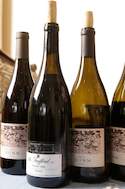One national wine competition De Trafford does occasionally enter is the SA Trophy Wine Show. And, in 2003, this tiny cellar, having won the trophy for best merlot and best cabernet sauvignon, as well as the merlot being judged best red tasted, shared top honours with vaunted corporate-owned winery Vergelegen as the most successful producer on the show.

What these successes did do was justify David Trafford decision towards the end of the 1990s to devote himself full-time to winemaking (he had been working as an architect, albeit from home).
Even so, he continued to be drawn into accepting the odd project, mostly for noted Cape restoration architect John Rennie, as well as work for wineries (Glenwood and Meerlust's grappa cellar). 'Until a few years ago, when I finally realised I just couldn’t keep on doing both.' Especially given the Traffords had embarked upon an exciting, pioneering winemaking project.
In 2001, while exploring up-river from the Breede River estuary on a weekend break on the Cape south coast, David recalls salavating when I saw the “puddingstone” broken slate soils reminiscent of Châteauneuf-du-Pape and Priorat [Spain]' stretching along a plateau between Malgas and Cape Infanta.
The former ostrich and grain farm called Lemoentuin came on the market in 2003. Running from the plateau down to the Breede River, it was snapped up by the Traffords with backing from investors: environmental businessman Quentin Hurt and Simon Farr of UK importers Bibendum Wine.
Some 15 hectares of naturally low-yielding bush vine reds suited to the Mediterranean conditions were planted: shiraz, mourvèdre, cabernet sauvignon, two-port varieties also suitable for table wine (Touriga naçional and trincadeira) and three whites (Chenin blanc, viognier, and Roussanne).
The first, highly distinctive wines under the Sijnn label (the name by which the river was known by the region's former indigenous Khoisan inhabitants) were made in rented cellar space in Stellenbosch in 2007.
The sole vineyard within a radius of 40 kilometres and quite unlike its nearest viticultural terroirs, it now forms part of the newly designated Malgas wine ward.
'Still a work in progress,' says David. But the aim is to eventually deliver three wines 'fully expressive of the already strong sense of place these early vintages are showing': a red, a white, and rosé. There is also a plan to build a small cellar there sometimes: a good excuse for the architect vintner to pull his drawing board closer...
 South African traditional Durban curry recipe by cellar master David Trafford paired with Sijnn Rosé wine....
South African traditional Durban curry recipe by cellar master David Trafford paired with Sijnn Rosé wine.... Pork belly recipe by David Trafford with roasted sweet corn and red pepper salsa served with roast sweet potatoes and dates....
Pork belly recipe by David Trafford with roasted sweet corn and red pepper salsa served with roast sweet potatoes and dates....